Speed sensor | Monitors and controls drives
- Details
- Hits: 9508
In industry, speed sensors record and monitor the Speeds of drives based on the principle of an inductive sensor or a magnetic sensor. Discover the latest developments in speed sensors, also known as tachometers. Our article presents Speed sensor-News, explains a wide range of possible uses and answers the most important questions about these precise measuring devices.

Contents
Speed sensor 2024 – The most important things in brief
In industry, speed sensors play a crucial role in monitoring and controlling machines or objects. Current developments These sensors aim to improve precision and reliability, especially when detecting rotational movements in a complex magnetic field. Higher precision, robustness and improved integration into automated systems are further goals of the developers.
A pair of trend is the advancing miniaturization that makes speed sensors more compact and therefore suitable for a wider range of industrial applications. There is also an increasing focus on wireless and IoT-enabled sensors that enable more efficient data transmission and remote monitoring. The integration of advanced signal processing and real-time data analysis increases the accuracy and reliability of speed measurement, which is essential for optimizing production processes and reducing downtime.
Speed sensor for mobile machines
06.01.2024 | Lenord + Bauer presents an innovative solution for mobile machines with the robust speed sensor GEL SEI10 (picture above). This sensor was designed for challenging environmental conditions.
The Rev counter Guarantees a high level of mechanical stability thanks to its robust stainless steel housing and the robust cable gland, meaning that no additional cable protection is required. The fully encapsulated electronics reliably protect against moisture, dirt and vibrations. This makes the GEL SEI10 suitable for use in construction machinery, agricultural vehicles and hydraulic systems.
 encoders | Industrial Ethernet and Industry 4.0 encoders
encoders | Industrial Ethernet and Industry 4.0 encoders
The sensor's ability to provide precise speed and position information applies to both electric motors as well as for Transmission. It offers a significantly higher resolution thanks to the Jitter-free and phase-accurate Evaluation of all four edges of the AB signal. This allows the engine to run with low vibrations at low speeds and high loads.
A Power supply From 5 to 30 V DC, the tachometer adapts flexibly to different systems. It also meets Safety Integrity Level 2 (SIL2), which guarantees the highest safety standards. This technology has already been successfully used in a different design in the field of e-mobility.
Speed sensors with a variety of signal outputs
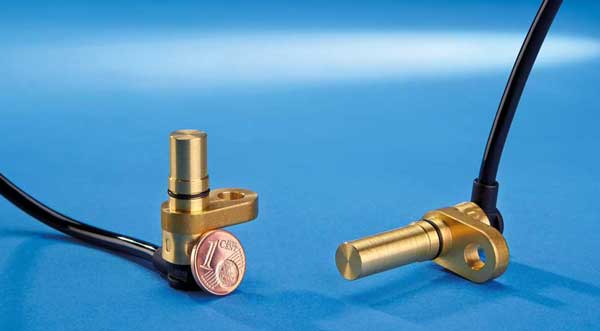 05.05.2020/XNUMX/XNUMX | the Speed sensors of the FE series from Rheintacho offer a variety of different signal outputs. They match with IP67 and IP6K9K the highest protection requirements. Two different immersion depths are available as standard with 18,4 and 32 mm. This allows users to select the optimal sensor for the respective installation situation.
05.05.2020/XNUMX/XNUMX | the Speed sensors of the FE series from Rheintacho offer a variety of different signal outputs. They match with IP67 and IP6K9K the highest protection requirements. Two different immersion depths are available as standard with 18,4 and 32 mm. This allows users to select the optimal sensor for the respective installation situation.
The waiver of one directly on the sensor body integrated connector increases the flexibility of the speed sensor. This reduces the risk of the connector being attached at a structurally disadvantageous point in the overall system. Another advantage of the cable outlet is the relocation of the connector to a more suitable position in terms of space and environmental conditions.
The speed sensor becomes less, particularly with regard to the ambient conditions Moisture, dirt and exposed to vibration. The Vibration is not to be underestimated. To protect against the ingress of moisture, plugs molded directly onto the cable or plugs overmolded on the rear are used.
Speed sensor with one channel, two channels or PWM
The FE speed connectors are available with the following Output signals: 1-channel for speed detection, 2-channel for detection of speed and direction of rotation and a pulse-width modulated current signal also for detection of speed, direction of rotation and diagnostic options.
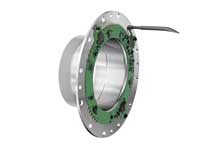 Measuring torque with sensors inside the transmission
Measuring torque with sensors inside the transmission
A sensor series is specified and approved for an application. The mechanical interfaces are identical, regardless of which signal you choose. Choose the right speed sensor precisely for the requirements of the application.
Hall sensor measures speed and direction of rotation in the magnetic stirrer
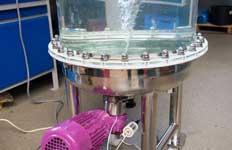 03.01.2024/XNUMX/XNUMX | To record the speed of its Vpuremix magnetic stirrers, AWH was looking for a compact solution for all sizes of the device series. Developed specifically for this task Turck a Hall sensor that records the exact speed of the mixing head in the container through the stainless steel wall. Thanks to a double Hall probe, the magnetic field sensor also detects the direction in which the mixing heads move.
03.01.2024/XNUMX/XNUMX | To record the speed of its Vpuremix magnetic stirrers, AWH was looking for a compact solution for all sizes of the device series. Developed specifically for this task Turck a Hall sensor that records the exact speed of the mixing head in the container through the stainless steel wall. Thanks to a double Hall probe, the magnetic field sensor also detects the direction in which the mixing heads move.
Tension belt encoder for angle and speed measurement on shafts
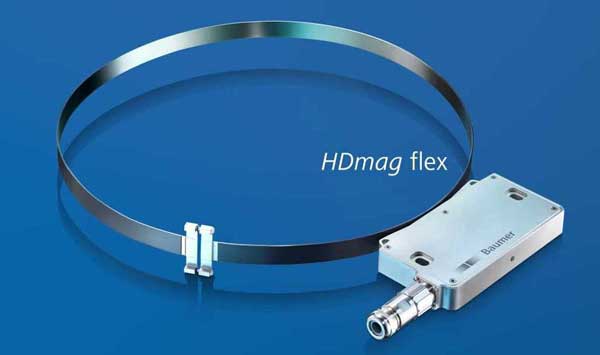 03.12.2013/XNUMX/XNUMX | With the new HDmag flex it works Baumer new ways of precise speed measurement and angle measurement on large shafts. The tension band dispenser is optimized for any, unlimited diameters, as shown in Wind Turbines or at largedriven z. B. can be found in rolling mills and steel mills.
03.12.2013/XNUMX/XNUMX | With the new HDmag flex it works Baumer new ways of precise speed measurement and angle measurement on large shafts. The tension band dispenser is optimized for any, unlimited diameters, as shown in Wind Turbines or at largedriven z. B. can be found in rolling mills and steel mills.
The precisely coded magnetic Measuring standard is manufactured to match the size of the desired shaft and rolled up for transport. For assembly, it is simply put around the generator or drive shaft like a belt and fixed with a turnbuckle. One person is enough even on the biggest waves. The shaft remains fully assembled. There are no costs for dismantling and adjustments.
Patent pending RPM measurement
Every variant of the tension belt encoder for measuring speed and angle of rotation can be delivered immediately, even individual pieces without initial costs. This enables a to Patent registered concept:
The rotary encoder to roll up
The factory adjustment more flexible Sensor units am Readhead on the ordered shaft diameter ensures an optimal sensor arrangement. The intelligent real-time signal processing always delivers the selected signal resolution, regardless of shaft diameter and tolerances.
Incremental and absolute sensors
The HDmag flex portfolio includes incremental and quasi-absolute speed measuring devices for measuring speeds. Due to its small axial depth, the tachometer only needs little space. A large air gap of up to 3 mm and an axial offset of up to ±5 mm between the scanning head and the measuring scale are permitted. This simplifies the adjustment of the components and guarantees absolutely reliable measurement results in this measuring method during operation. Thanks to its bearing-free design and non-contact operation, HDmag flex works practically wear-free for years.
The Electronics in the readhead is completely encapsulated and therefore insensitive to dust, dirt, shock and vibration. As a standard, up to 131.072 pulses per revolution are possible. The quasi-absolute version offers a position resolution of up to 20 bits and additional digital speed signals with a resolution of up to 18 bits.
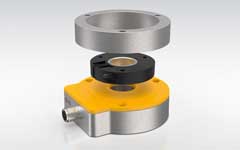 Encoder with IO-Link without bearings and explosion-proof
Encoder with IO-Link without bearings and explosion-proof
A function monitoring permanently checks essential encoder functions and visualizes the device status via a multi-colored LED. It also assists in setup by indicating that the radial distance between the scanning head and the magnetic tape is too great.
FAQ
What is the speed sensor?
A speed sensor, also called a tachometer, is a device used to measure the rotational speed or rotational frequency of a rotating object. It converts the mechanical movement into an electrical signal, which can then be analyzed to determine the speed.
What kind of speed sensors are there?
Speed sensors come in various technologies including:
- Optical Sensors measure speed by projecting light pulses onto a rotating object and counting the reflected pulses.
- magnetic Sensors use changes in the magnetic field created by the movement of a magnetic object or a magnet on the rotating part.
- Inductive Sensors record speed by detecting changes in the electromagnetic field caused by metallic objects moving past them.
- Hall effect-Sensors use the Hall effect to measure speed by detecting the change in the magnetic field near the sensor.
How does an inductive speed sensor work?
An inductive speed sensor records this Changes in the electromagnetic field, which occur when a metallic object, such as a gear or cam, rotates near the sensor. The sensor consists of a coil and a magnetic core. When a metallic object moves past the coil, it changes the magnetic field around the coil, resulting in a change in the inductance of the coil. This change creates an electrical voltage or signal in the coil that is proportional to the movement of the metallic object. By counting these voltage pulses or signals, the speed of the object can be determined.
Where are speed sensors used?
Speed sensors are used in many industrial applications such as automotive, manufacturing, monitoring motors, pumps and other rotating machines. They are crucial for monitoring and controlling processes where accurate speed measurements are required.
Source: This article is based on information from the following companies: Baumer, Lenord+Bauer, Rheintacho, Turck.
You might also be interested in...
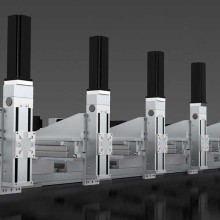
Positioning drive | For precise format adjustment
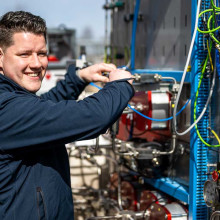
IO module secures Resato hydrogen filling stations
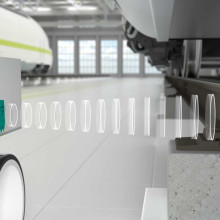
RFID and Barcodes | Industrial identification
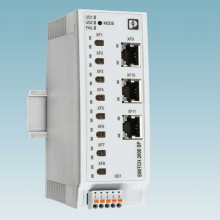
Ethernet switches | The data driver in the network

LED signal light with and without IO-Link

Turck | Your global automation partner

Angela Struck is editor-in-chief of the development scout and freelance journalist as well as managing director of Presse Service Büro GbR in Ried.
